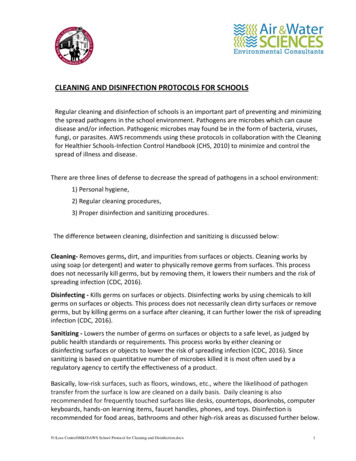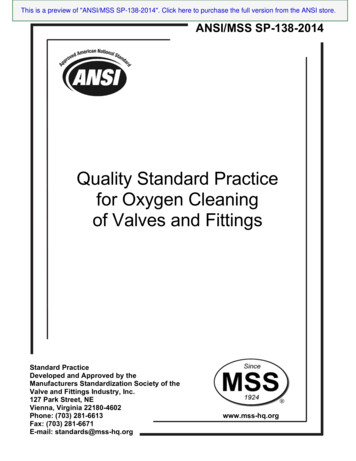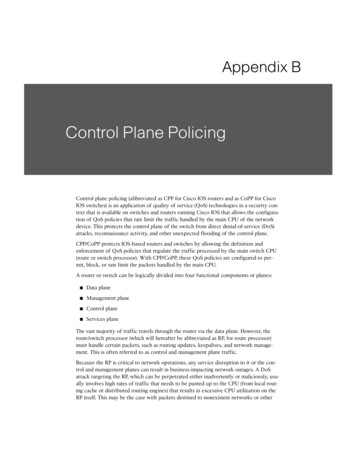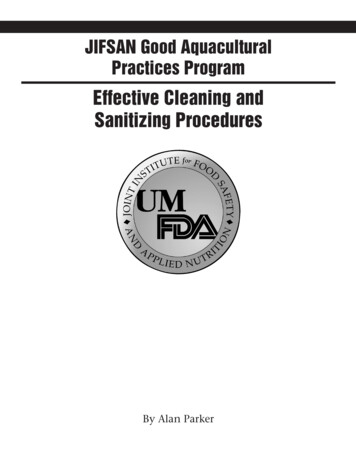
Transcription
Air&Water SCIENCESEnvironmentalConsultantsCLEANING AND DISINFECTION PROTOCOLS FOR SCHOOLSRegular cleaning and disinfection of schools is an important part of preventing and minimizingthe spread pathogens in the school environment. Pathogens are microbes which can causedisease and/or infection. Pathogenic microbes may found be in the form of bacteria, viruses,fungi, or parasites. AWS recommends using these protocols in collaboration with the Cleaningfor Healthier Schools-Infection Control Handbook (CHS, 2010) to minimize and control thespread of illness and disease.There are three lines of defense to decrease the spread of pathogens in a school environment:1) Personal hygiene,2) Regular cleaning procedures,3) Proper disinfection and sanitizing procedures.The difference between cleaning, disinfection and sanitizing is discussed below:Cleaning- Removes germs, dirt, and impurities from surfaces or objects. Cleaning works byusing soap (or detergent) and water to physically remove germs from surfaces. This processdoes not necessarily kill germs, but by removing them, it lowers their numbers and the risk ofspreading infection (CDC, 2016).Disinfecting - Kills germs on surfaces or objects. Disinfecting works by using chemicals to killgerms on surfaces or objects. This process does not necessarily clean dirty surfaces or removegerms, but by killing germs on a surface after cleaning, it can further lower the risk of spreadinginfection (CDC, 2016).Sanitizing - Lowers the number of germs on surfaces or objects to a safe level, as judged bypublic health standards or requirements. This process works by either cleaning ordisinfecting surfaces or objects to lower the risk of spreading infection (CDC, 2016). Sincesanitizing is based on quantitative number of microbes killed it is most often used by aregulatory agency to certify the effectiveness of a product.Basically, low-risk surfaces, such as floors, windows, etc., where the likelihood of pathogentransfer from the surface is low are cleaned on a daily basis. Daily cleaning is alsorecommended for frequently touched surfaces like desks, countertops, doorknobs, computerkeyboards, hands-on learning items, faucet handles, phones, and toys. Disinfection isrecommended for food areas, bathrooms and other high-risk areas as discussed further below.N:\Loss Control\M&O\AWS School Protocol for Cleaning and Disinfection.docx1
The spread of pathogens can be minimized in schools be employing good personal hygiene,regular cleaning and the proper use of disinfectants. These three lines of defense are detailedbelow:PERSONAL HYGIENEThe use of good personal hygiene by students, staff and visitors can greatly reduce the spreadof pathogens in the school. These can include the following components:1) Proper hand-washing hygiene. Make sure all building occupants have access to adequatesoap, water and drying mechanisms (air dryers or paper towels). Supply adequate trainingand signage on proper hand-washing techniques through-out the school.2) Ensure building occupants practice proper sneeze and cough etiquette with ample signageand training. Coughing into the elbow is an alternative when tissues are not available. Usetissues when possible to capture droplets and dispose of them in a waste receptacle afteruse.3) Train coughing or sneezing students/staff to leave a 3-foot buffer between themselves andothers.4) Provide training to building occupants on the importance of not sharing drinks, cups, foodand paper towels.REGULAR CLEANINGComprehensive cleaning programs that use less-toxic products and updated tools andtechnology can help control the spread of infectious disease and illness. Cleaning is the manualremoval of microbes, dirt, dust and allergens from a surface. Cleaning surfaces with microfibercloths and mops and an all-purpose cleaner can be effective at removing 99.9 % of microbes(EPA, 2002). Most pathogenic microbes cannot live on a clean and dry surface for very longtherefore physical removal of the nutrients (including dust) and moisture needed to surviveand multiply is an effective first-step in preventing the transmission of diseases.Basic Surface Cleaning Procedures1. Wash surfaces with a certified all-purpose cleaner and a microfiber cloth.2. Rinse and/or wipe surfaces if required.3. Rinse cloth in clean water after each surface.4. Reapply the cleaning solution for the next surface.5. After the cleaning process is complete, rinse out microfiber cloths and hang to dry, orleave for pick-up by the custodial staff.N:\Loss Control\M&O\AWS School Protocol for Cleaning and Disinfection.docx2
In the Cleaning for Healthier Schools –Infection Control Handbook (CHS, 2010) the followingcleaning schedule for specific school surfaces are recommended:Desks, Work Tables, and Computer Keyboards – SharedProducts: An all-purpose cleaning product and a high-quality microfiber cloth. Keyboard coversare more easily cleaned than the keys.Recommended cleaning schedule: Clean daily.During outbreak of gastrointestinal illnesses or flu: Clean in between usesor after each group session.Desks, Work Tables, and Computer Keyboards – Not SharedProducts: An all-purpose cleaning product and a microfiber cloth.Recommended cleaning schedule: Clean weekly or as needed.Cafeteria Tables and FloorsProducts: A cleaning detergent that removes dirt and allergenic protein matter, and highquality microfiber cloths/mops. Sponges are not recommended due to their potential tospread contamination).Recommended cleaning schedule: Clean after each use, before the next group arrives.Other Surfaces Touched by a Variety of Hands (phones, light fixtures, stair railings, door knobsand push bars, elevator buttons, water fountains, etc.)Products: An all-purpose cleaning product and a high-quality microfiber cloth.Recommended cleaning schedule: Clean daily.During outbreak of gastrointestinal illnesses or flu: Clean touch points in between classes orperiodic events.Floors in Classrooms and HallwaysProducts: A neutral floor-cleaning product specific to flooring material that removes dirt yearround (and salt in the wintertime), and a microfiber mop.Recommended cleaning schedule: Clean daily.DISINFECTIONDisinfectants are EPA registered pesticides designed to kill or inactivate microbes (germs). Theoveruse or misuse of disinfectants can kill healthy bacteria and also lead to disease-resistantstrains of pathogens. In additional, many disinfectants contain toxic ingredients have beenidentified as respiratory irritants, while others are considered asthmagens (IGS, 2009).Disinfecting is a process that kills or irreversibly inactivates microbes (bacteria, fungi, andviruses) present on a nonporous surface but does not necessarily kill their spores. The productlabel identifies which microbes it has been tested to kill or inactivate. Disinfectants accomplishthis by breaking down the microbes’ cell walls or by otherwise deactivating them (CHS, 2010).Disinfectants should be used for bathrooms, showers, locker rooms, child-care facilities withdiaper changing stations, food preparation surfaces where disinfection or sanitization isN:\Loss Control\M&O\AWS School Protocol for Cleaning and Disinfection.docx3
required, for bloodborne pathogens cleanup and any other high-risk areas. High-risk areas arelocations where there is a higher risk for bloodborne incidents, skin contact (MRSA risk), orcontact with feces and body fluids. Examples of high-risk areas include the nurse’s office,athletic areas, and childcare centers. These surfaces and areas should be cleaned anddisinfected daily (CHS, 2010).Many facilities choose to use a combination disinfectant/cleaner to minimize the number ofproducts and number of steps required to clean and disinfect the building. Even thoughcombination products have been developed to both clean and disinfect, the best practice is toclean a surface first and then apply the disinfectant. Some disinfectants lose effectiveness inthe presence of dirt, dust and other organic matter. The disinfectant should be left on thesurface for the recommended amount of dwell or kill time and then rinsed or wiped (ifrecommended). Since different products have specific dwell times, ranging from 30 seconds to20 minutes; check the label’s instructions (IGS, 2009). Cleaning first and then applying thedisinfectant for the recommended dwell time ensures that you are truly disinfecting thesurface and not creating microbial resistance. When the disinfectant is not allowed the fulldwell time, the microbes that survive may develop resistance to the disinfectant and become“super bugs” that cannot be controlled by that disinfectant. Always follow the manufacturer’sinstructions found on the product label (IGS, 2009).Disinfection Procedures (CHS, 2010) Identify school personnel (e.g. custodian, nurse) responsible for disinfecting. Limit the use of disinfectants to: bloodborne pathogens cleanup, food preparationsurfaces where disinfection or sanitization is required and high-risk areas as mentionedabove (nurse’s office, athletic areas, and childcare centers). Allow only EPA-registered disinfectants for use in the facility. Prohibit the use ofcleaning and disinfecting products that have been brought in by staff or parents withoutschool review and approval. Avoid using products with a strong scent that may trigger asthma and allergycomplaints. Scented products may also contain known hormone disruptors (substancesthat interfere with our endocrine system and can cause reproductive issues, earlyfemale development, thyroid disorders, polycystic ovarian syndrome, genitaldeformities in newborn boys, etc.) Microfiber is recommended for use with disinfectants and can help prevent crosscontamination. Avoid using sponges in a school setting, as they are difficult to disinfect.Launder your cleaning cloths and mop heads/pads daily. Disinfect only after school hours except in the case of an incident, such as vomit, feces,bloodborne pathogens clean-up, or as written in the protocol.N:\Loss Control\M&O\AWS School Protocol for Cleaning and Disinfection.docx4
Disinfection Protocol (IGS, 2009)1. Select – Identify the least product that will control the targeted microbes (H1N1, MRSAetc.). Look for an HMIS or NFPA Health Rating of 0-1 applied to the product as used. Therating may be found on the product's label and/or material safety data sheet (MSDS).2. Clean – Clean the surfaces to be disinfected with a third-party certified all-purpose cleanerand a microfiber cloth first. Rinse or wipe the surface as required.3. Ventilate - Make sure there is ventilation in the work area, e.g., an open window or anoperating HVAC system.4. Use proper personal protective equipment (PPE)-such as chemically resistant gloves, ifrequired by the label. Other PPE such as respirators or coverall may also be required perthe MSDS or the label5. Dilute the Product - Follow the label instructions for the proper dilution ratio, if theproduct is a concentrate. Follow the manufacturer’s instructions exactly. If using aconcentrated product, do not add more concentrate hoping to create a more effective orstronger solution. This is wasteful, can actually be less effective and may leave a harmfulresidue behind that could cause skin rashes and other harmful health effects for studentsand staff.6. Apply to the Surface - Use a pump-spray or squirt bottle to apply the product by:a. Saturating the microfiber cloth with the disinfectant and wiping the surfaceleaving a wet film. Make sure there is enough disinfectant on the cloth to coverthe surface to be disinfected and ensure that it will remain wet for the requireddwell time. Spraying into the cloth first minimizes the dispersion of product intothe air where it can be inhaled.b. Directly squirting the solution on the surface and using a microfiber cloth todistribute evenly.7. Dwell Time – Leave the disinfectant on the surface for the amount of dwell time (timeneeded for the disinfectant to kill the microbes) required on the product label.8. Remove Residue - Rinse or wipe the surface, if required. Rinsing removes any toxicresidue that may be left on the surface that could be transferred to skin. Not alldisinfectants leave a residue.9. Allow to Dry – Allow the surface to dry before use.Disinfecting in the Classroom by Teachers (if permitted)If the district or school allows disinfectant products to be used by teachers or other staff, thefollowing guidelines are recommended:1. Do not ask students to use disinfectant products. Children’s developing bodies are muchmore susceptible to the effects of chemicals than the bodies of most adults. Disinfectantsprays and wipes can contain ingredients that are recognized as asthmagens and scentedproducts can contain ingredients identified as hormone disruptors. Use disinfectantproducts only after students have left the building.N:\Loss Control\M&O\AWS School Protocol for Cleaning and Disinfection.docx5
2. Train teachers on the proper use and storage of disinfectants and on the HazardCommunication Law which will help them interpret the product management and healthand safety information provided in the product’s material safety data sheet (MSDS).Provide copies of the MSDS in case of an accident in the classroom.3. Use only non-scented disinfectant products because scented products can triggerasthma and allergy episodes.4.Provide chemically resistant gloves as specified on the product’s MSDS or label.5. Ensure that the products are stored properly in a secured area away from students,with other compatible chemicals. Check the product’s MSDS to determine how to safelystore the disinfectant.References:Environmental Protection Agency (EPA), Using Microfiber Mops in Hospitals, EnvironmentalBest Practices for Health Care Facilities. Region 9 Pollution Prevention Program. 2002.Informed Green Solutions, Inc./ Cleaning for Health (IGS)/ 802-626-8643, 2009Cleaning for Healthier Schools –Infection Control Handbook (CHS), National Cleaning forHealthier Schools and Infection Control Workgroup, Lynn Rose and Carol Westinghouse, 2010.How To Clean and Disinfect Schools To Help Slow the Spread of Flu, Centers for Disease Controland Prevention (CDC) National Center for Immunization and Respiratory Diseases (NCIRD) 2016N:\Loss Control\M&O\AWS School Protocol for Cleaning and Disinfection.docx6
Basic Surface Cleaning Procedures 1. Wash surfaces with a certified all-purpose cleaner and a microfiber cloth. 2. Rinse and/or wipe surfaces if required. 3. Rinse cloth in clean water after each surface. 4. Reapply the cleaning solution for the next surface. 5. After the cleaning process is complete, rinse out microfiber cloths and hang to dry, or










